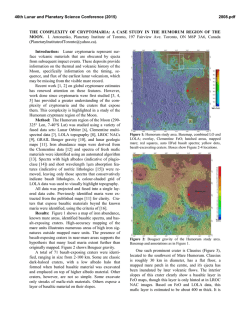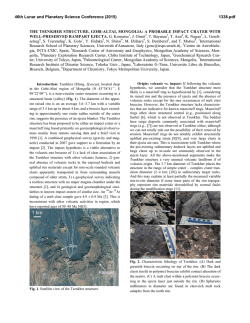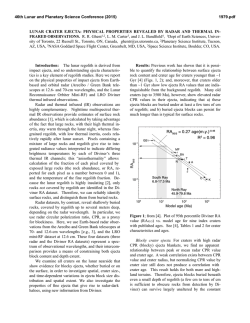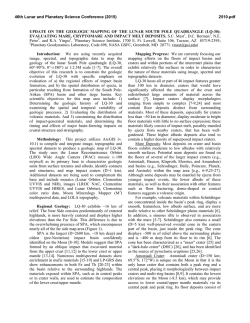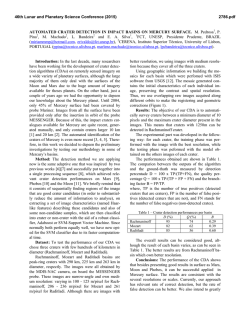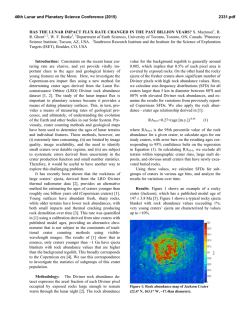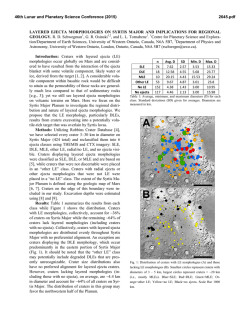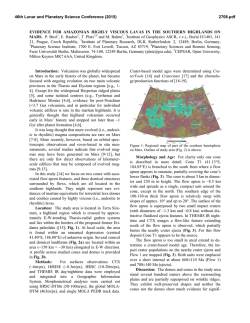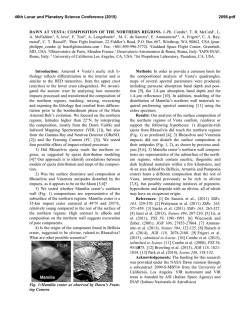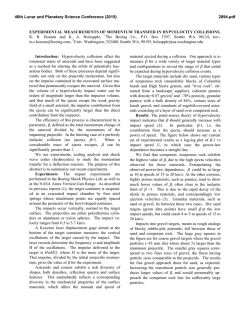
THE REMARKABLE HOKUSAI CRATER, MERCURY. Olivier S
46th Lunar and Planetary Science Conference (2015) 2672.pdf THE REMARKABLE HOKUSAI CRATER, MERCURY. Olivier S. Barnouin1, Carolyn M. Ernst1, and Hannah C. M. Susorney2 1The Johns Hopkins University Applied Physics Laboratory, Laurel, MD 20723, USA ([email protected]); 2Department of Earth and Planetary Sciences, The Johns Hopkins University, Baltimore, MD 21218, USA. Introduction: Hokusai crater on Mercury, centered at 57.80ºN, 16.72ºE, hosts fluidized ejecta deposits that are unlike those of most craters on the innermost planet [1] but are similar to those of rampart craters on Mars. Single-layered ejecta, typical of ejecta of rampart craters on Mars, result from a ground-hugging flow that enhances the run-out distance of the continuous ejecta following either ballistic emplacement [2] or entrainment by an atmosphere [3]. At Martian craters with single-layered ejecta [4], these deposits typically include a sharp distal rampart separated from the nearrim ejecta deposits by a moat with minimal ejecta thickness. These single-layered deposits differ markedly in morphology from landslides, which usually possess substantial thickness across the run-out directions of the deposit, slowly thickening before terminating at a broad rampart [4]. This variation in morphology is likely the result of different ejecta emplacement dynamics. We investigate the geomorphology of Hokusai with topographic data acquired by the Mercury Laser Altimeter (MLA) and images from the Mercury Dual Imaging System (MDIS) on the MErcury Surface, Space ENvironment, GEochemistry, and Ranging (MESSENGER) spacecraft. We compare and contrast Hokusai with other craters of similar size and freshness on Mercury to highlight its distinctive attributes, to assess the factors that might have contributed to the formation of its fluidized ejecta, and to illuminate ejecta fluidization processes more generally. Observations: The bright rays of Hokusai indicate that it is one of the freshest large craters on Mercury. Its young age is confirmed with high-resolution MDIS images (17–36 m/pixel) that reveal few small (<300 m diameter) superposed craters on this 97.3-km-diameter crater (Figure 1). Despite the fact that fresh craters are usually deeper than older craters of similar diameter [5], Hokusai crater is not particularly deep. Several MLA profiles (e.g., Figure 1) that pass near its center indicate that, at 2.3 km depth from rim crest to crater floor, it is shallower than many other complex craters of similar size that are more degraded (e.g., Atget [6]). Hokusai is also shallower than several other smaller fresh craters with bright rays (e.g., Cunningham and Fonteyn). Figure 2. Distal rampart separated from inner ejecta by a moat at Hokusai crater. The ejecta in the moat possess minimal thickness, as indicated by elevation relative to the height of surrounding terrain (indicated by the white dashed line). Figure 1. Hokusai crater with MLA profile. The black box outlines the region shown in Figure 2. White arrows indicate distal ejecta ramparts. The most intriguing features of Hokusai crater are observed in its near-rim ejecta field. The MLA data indicate that the change in ejecta thickness with distance from the crater rim is not well modeled by a power-law function with a -3 exponent, as is often used to describe ejecta emplaced ballistically [7]. Surface roughness [8] around this crater has a different pattern with radial distance from that for other fresh craters on Mercury. This difference is associated with the ropey properties of Hokusai’s near-rim ejecta, and a less well pronounced secondary ejecta field relative to similar-sized craters Abedin and Stieglitz, which, like Hokusai, are within the northern smooth plains. 46th Lunar and Planetary Science Conference (2015) Surrounding about two-thirds of the crater (Figure 1), the ropey ejecta is bounded by a terminal rampart. In many instances, the distal ramparts are separated by a moat from the continuous ejecta and can be ~500 m in height (Figure 2). Although the heights of Hokusai ramparts are large relative to Martian ones (~200 m for similar-sized craters [4]), these features are otherwise morphologically identical to single-layered ejecta facies seen on Mars [4]. The run-out distance of the continuous Hokusai ejecta (as delineated by its ramparts) is less (<1 crater radius) than for equivalent-sized, single-layer ejecta craters on Mars (>2 crater radii). The single-layered ejecta morphology observed at Hokusai is not observed at other Mercury craters reported to possess ejecta flows [1]. The thin ejecta deposits (<20 m; Figure 2) in the moat that separates the inner ejecta from the tall but narrow distal ramparts are not observed at these other craters. In contrast, the ejecta deposits seen at these other Mercury craters have broad, low-curvature distal rises, resembling landslides [6], and MLA measurements reveal that the outer portions of the ejecta deposits are thick (500–800 m in the case of a 60-km-diameter crater located at 45ºN, 288ºE). These landslide-like flows form on a pre-existing slope (>5°) [1] and appear to be the result of outward slumping of a crater rim, like those reported at Tsiolkovsky basin on the Moon [9]. In contrast, the Hokusai singled-layered ejecta formed on terrain with a very small (<1°) regional slope. Clues to origin of fluidized ejecta: The strong similarity between Hokusai’s ejecta and single-layered ejecta on Mars is unexpected despite the fact that both planets have similar surface gravitational acceleration. The usual factors invoked to explain the fluidization of ejecta on Mars include water or an atmosphere, neither of which can account for the ramparts of Hokusai on Mercury. A possible clue to the origin of Hokusai’s fluidized ejecta might be its moderate depth. However, variations in local terrain on Mercury are probably not the cause of differences in observed crater depth [6]; craters with similar low degradation states (Classes 4 and 5 [10]) possess similar average depths, whether in heavily cratered terrain or smooth plains. Likewise, there is no relationship between the single-layered ejecta seen at Hokusai and target properties, given that Abedin and Stieglitz do not show similar ejecta morphology. That Hokusai is somewhat shallow more likely reflects the influence of the impactor. Hokusai shows evidence of being the result of an oblique impact; its asymmetric rays, the horseshoe shape of its central ring [11], and the lack of terracing on the northeast sections of its wall all indicate such an origin. Impact velocity, which varies markedly on Mercury from 15 to 75 km/s [12], might be an alternative con- 2672.pdf tributing factor to the formation of single-layered ejecta. For a given crater size, calculations [e.g., 13] indicate that a high-velocity impact on Mercury (~75 km/s) should produce a factor of ~3 greater volume of impact melt than a mean-velocity (~40 km/s) impact. Hokusai crater has an unusually large amount of impact melt in its interior, as much as 200–400 m greater thickness than in other similar-sized craters, on the basis of differences in peak-ring heights. Impact melt at Hokusai can also be observed in many local depressions within the terraces of its wall, and in many patches located throughout its ejecta deposits. These observations are in contrast to those at Atget, and melt patches are visible only in a small northwestern section of the ejecta of Abedin. Discussion: The origin of the Hokusai’s singlelayered ejecta with its distal ramparts is currently not well understood. An important clue to the origin of the fluidized ejecta seen at Hokusai may be the unusually large volume of melt, which could have intermixed with the solid ejecta to allow it to flow easily and then stop to form ramparts. This mechanism would be a Mercury analogue to the hypothesis that water was the principal contributor to single-layered ejecta on Mars [e.g., 2, 14]. References: [1] Xiao, Z. and Komatsu, G. (2013) Planet. Space Sci. 82, 62–78. [2] Carr, M.H. et al. (1977) JGR, 82, 4055–4065. [3] Schultz, P.H. and D. E. Gault (1979) JGR, 84, pp. 7669–7687. [4] Barnouin-Jha, O.S., et al. (2005) JGR, 110, E04010. [5] Cintala, M.J. et al. (1976) Proc. Lunar Planet. Sci. Conf. 7, 3575–3587. [6] Susorney, H.C. et al. (2013) LPS 43, abstract 1650. [7] McGetchin, T.R. et al. (1973) Earth Planet. Sci. Lett., 20, 226–236. [8] Susorney, H.C.M. et al. (2015) LPS 46, this volume.. [9] Guest, J.E. and Murray, J.B. (1969) Planet. Space Sci., 17, 121–141. [10] Trask, N. J. (1971), in U.S.G.S. Prof. Paper 750-D, D138–D144. [11] Schultz, P.H. (1992) JGR, 97, 16183–16248. [12] Le Feuvre, M. and Wieczorek, M.A. (2008) Icarus, 197, 291–306. [13] Roberts, J.H. and Barnouin, O.S. (2012) JGR 117, E02007. [14] Greeley, R. et al. (1980) Proc. Lunar Planet. Sci. Conf. 11, 2075–2097.
© Copyright 2025
